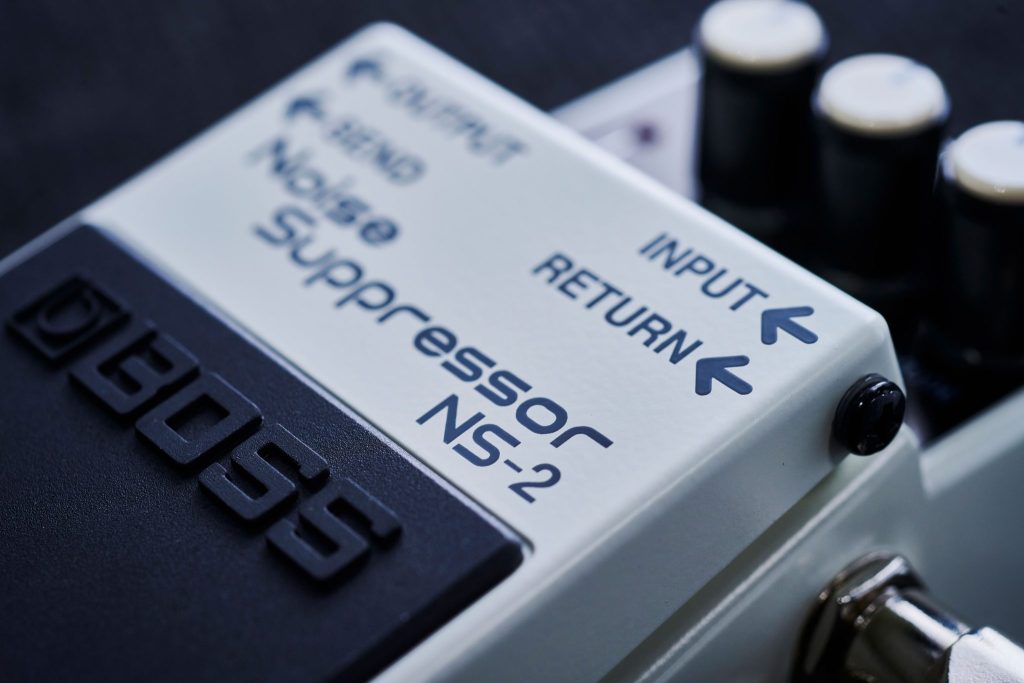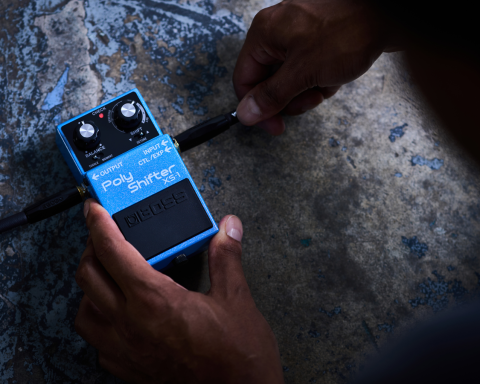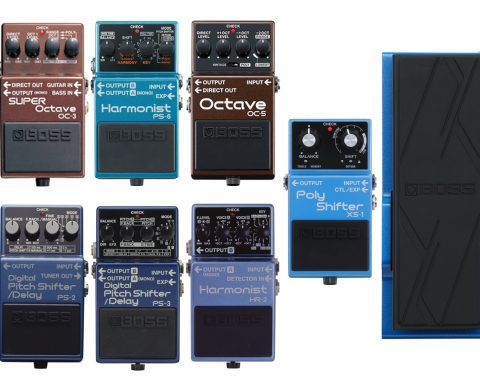A noise suppressor can be one of the most helpful tone-shaping tools on a guitarist’s pedalboard. At first glance, it’s probably the least glamorous of all effects pedals. Many players struggle to understand why they’d need one, especially if pedalboard real estate is at a premium. While noise suppressors don’t create an audible effect, they’re the icing on the cake of guitar tone. They tailor, shape, and refine the sound of the guitar, other pedals, and the amplifier itself. BOSS has been at the center of high-quality noise suppression for decades. The consistently popular BOSS NS-2 has remained in production unchanged since 1987. Learn to use a noise suppressor in unique and exciting ways.
What is a Noise Suppressor?
A noise suppressor’s primary purpose is to eliminate unwanted noise, hiss, and buzz from gain-enhancing elements in a setup. These sound sources include anything that raises the noise floor. Examples include high output pickups, gain-heavy effects, or high gain amplifiers.
Noise suppressors deal with these problems in several ways, both individually and simultaneously. Still, a noise suppressor does more than clean up the audio signal. This pedal can creatively tighten playing precision and even shape tone. Used correctly, it can be the cornerstone of a great guitar setup.
Setting a Noise Suppressor
Depending on the situation, there are many different ways to use a noise suppressor. Still, the pedal settings remain fundamentally similar. There are two critical controls to any noise suppressor, threshold and decay, similar to the basic controls of a compressor. Threshold controls the level at which the pedal begins to suppress any noise. Turned fully clockwise, the pedal will mute all guitar signal. Set the effect by dialing back the threshold control until it eliminates unwanted noise, leaving the guitar signal intact.
Decay controls how quickly the effect allows the signal to fade before it clamps back down on any errant noise. This control helps maintain a natural guitar tone. Setting a long decay time allows notes to ring out organically without the noise suppressor cutting them short. However, a short decay time is ideal for tightening up fast, staccato playing, emphasizing the stops as much as the notes.
NOISE SUPPRESsOR PEDAL USES
1. Gating with Overdrive (Single Channel)
How a noise suppressor gets implemented into a setup depends significantly on the equipment. A simple setup is a single-channel amplifier running a clean tone with a distortion pedal to create the standard, heavy tone for the rig.
Amplifier effects loops can be handy for getting the most out of a noise suppressor. Still, placing the noise suppressor after the distortion in a simple chain works fine. In this case, the distortion pedal creates an unwanted hiss. Now the distortion pedal’s gain controls can get pushed to their limits to create a crushingly heavy guitar tone. The noise suppressor will remove the noise floor and tighten the attack. Toggle the pedal on and off to allow chords to ring out with organic note decay.
"Any time-based pedals that rely on dynamics and decay, like delay and reverb, should come after the noise suppressor."
2. Four-Cable Method for Effects
Another prevalent method of using a noise suppressor in larger pedal setups is taking advantage of the pedal’s effects loop. Try running a guitar straight into the input of the noise suppressor with any overdrive or distortion pedals in the effect loop. This allows the noise suppressor to react solely to the guitar’s attack, creating organic sustain and decay.
Any time-based pedals that rely on dynamics and decay, like delay and reverb, should come after the noise suppressor. This way, they can function normally while the gain pedals get tightened and honed by the noise suppressor.

3. Simple Gating with Amp Gain (FX Loop)
Using an amplifier’s gain structure to create a thick, heavy overdrive tone is often the best route to classic high-gain tones. However, pushing a preamp creates a lot of amp noise and a loss of note clarity. Suppose the amplifier has its own effects loop. In that case, a noise suppressor can reduce preamp noise and get the absolute best out of the amplifier.
In this instance, look at the amplifier as two separate parts: the preamp, which creates gain and character, and the power amp, which creates volume. Most amp effects loops occur between the preamp and the power amp. This means that if a noise suppressor is in an amplifier’s effects loop, it functions after the gain stage. Any heavily pushed overdrive can get tamed and tightened without compromising the thick amp tone.
"A noise suppressor can reduce preamp noise and get the absolute best out of the amplifier."
4. Percussive Effect
A noise suppressor can be more than a tool for noise reduction. Used subtly, it can sound organic and natural, removing only the unwanted overdrive buzz and leaving the rest of the guitar tone intact. But, pushing a noise suppressor past its natural limits can create exciting results, perfect for the fast, choppy, staccato stabs of progressive metal. In fact, these pedals are crucial to the rigs of some of the world’s biggest, heaviest bands, like Metallica, Slipknot, and The Dillinger Escape Plan.
Try pushing the threshold and reducing the decay until they sound too short and tight. While this prevents any note sustain, it can be ideal for emphasizing a stabbed metal riff’s percussion, rhythmic nature.

"Try pushing the threshold and reducing the decay until they sound too short and tight. This can be ideal for emphasizing a stabbed metal riff’s percussion nature."
Hone the Clarity
The noise suppressor is the perfect tool for guitarists looking to hone the clarity of their tone. Sure, it may not be as superficially exciting as other effects. Yet, pros know the noise suppressor is a must-have. Guitarists who rely on gain-driven tones know precision and focused dynamic response are crucial. Nothing achieves that result like a noise suppressor.







